North Face Endurance Challenge California 50 miles 2014 race report
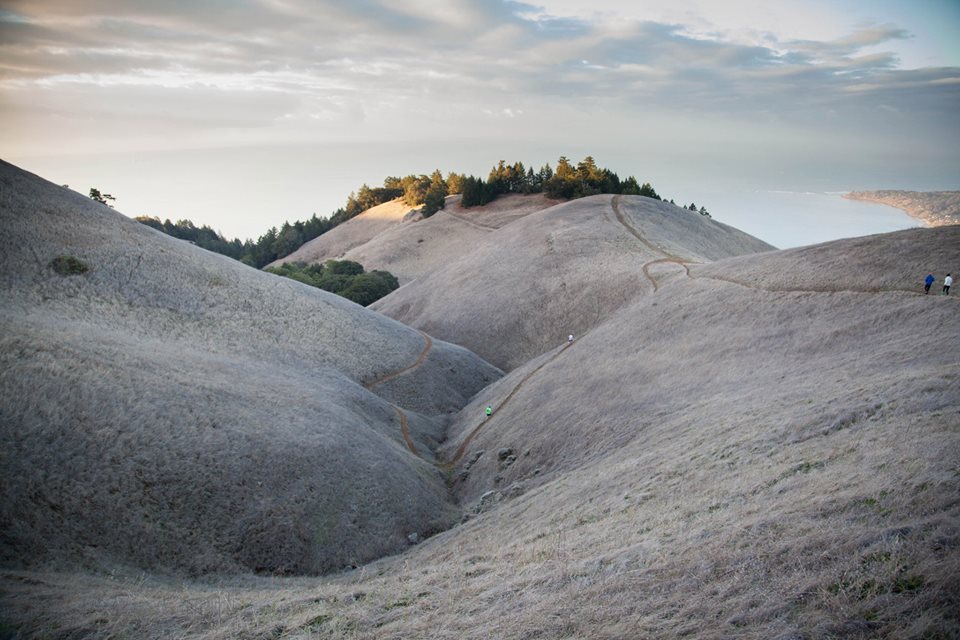
When I first heard about 50 mile run on the hills of Marin Headlands overlooking Pacific Ocean I immediately wanted to take part in it.
Later I looked through many different lists of ultra-running events searching for other options. Most of all, I liked list of qualifying races for UTMB (the most prestigious hundred-miler in Europe) - it’s quite complete and has complexity classification. The more difficult race the more qualification points earned for finishing it. For finishing North Face Endurance Challenge (NFEC) 50-miler 2 points given (out of 4 maximum). Having earned 8 point (in 3 or less races during 2 years) one get a chance to toe the starting line of the UTMB. Organizers themselves rate their race as hard as 5 out of 5 (the most difficult)
During time I’ve been in ultra-running community I’ve not meet 50-miler, attracting that much attention. High prize money, date at the end of season gather strongest runners from all over North America, and beautiful course plus great organization - general trail enthusiasts.
Preparation
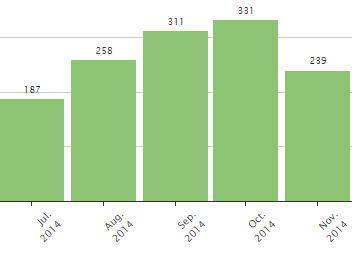
Training volume, km
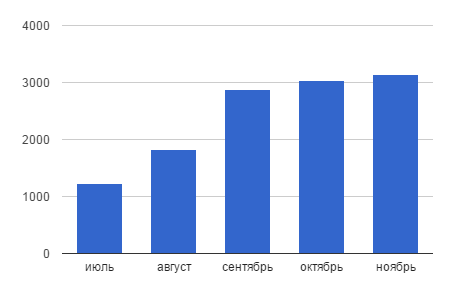
Total elevation gain, m
As shown in charts there was not too much volume. I had to reduce training load couple of times (one of those was after back-2-back long run 20+16 miles - I’ve made my conclusion). Besides, I did two “very long” runs - 30 and 40 miles.
Course
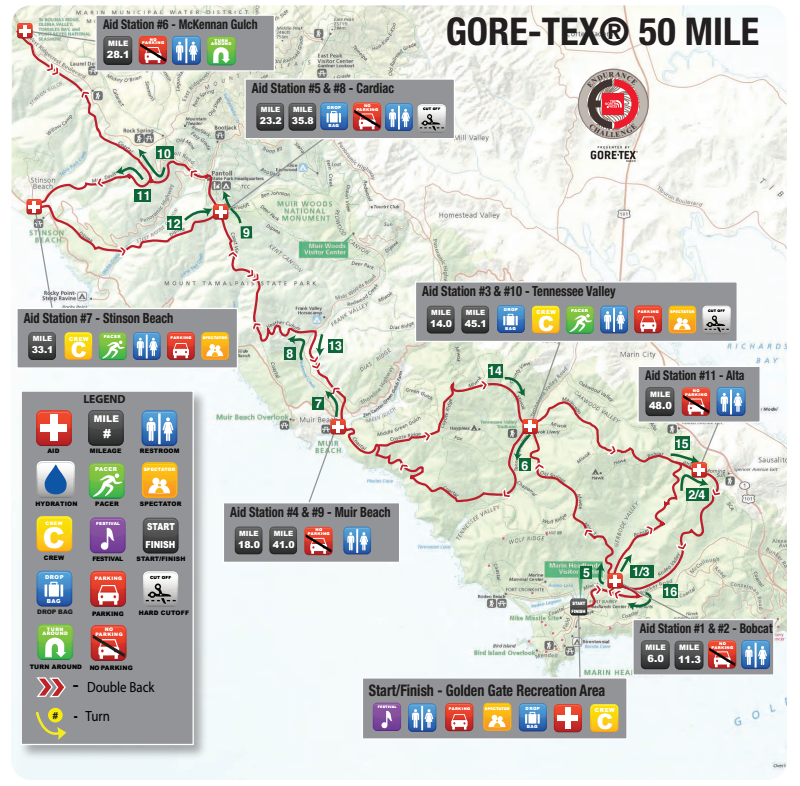
Course map, length 80.8 km (GPS data)
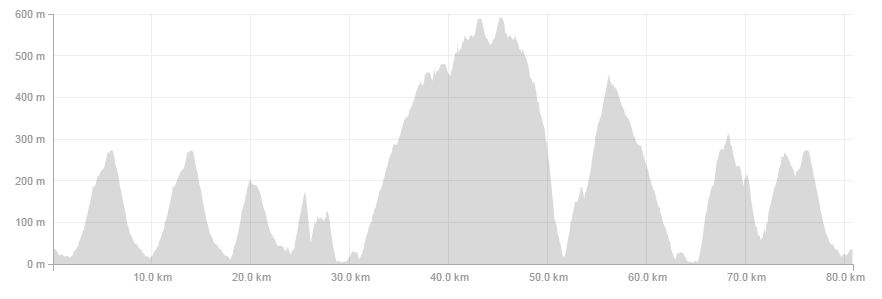
Elevation profile, total elevation gain 3051 m (GPS data)
Course runs through the hills of Marin Headlands, peninsula located in close proximity of San Francisco. This area is permeated with network of maintained trails which makes it a great place to do trail running. Width of the trail varies - from fire roads to singletrack. Overall, in case of no rain there are not much technical sections. In 2012 because of showers which was pouring during most part of the race the course was altered so it had to be run twice on the same loops. This time weather made it’s contribution again. Because of rains one of the bridges was washed away and course was changed day before the race. Looking ahead, I can say that descent after Cardiac aid station (on way back) after hundreds of runners and all water flowing down from the top become quite a brutal dirty mess. However it was not a big deal for me. Some sections are covered with Google Street View, besides there is a great video with course preview.
Before the start
At 3.20 AM I left hotel and headed out to shuttle bus. It was pouring with dense rain, flowing streams of water ran through the streets, my shoes get wet gradually. One bus has just departed, another one was waiting for it’s passengers. I loaded and we went off. A bit later driver stopped the car, and saying “How much energy we have here” took off his jacket wiped fogged glass with it and drove on. and Soon we were at the place. The rain stopped, in the dark could be seen outlines of the hills, where we had to run. The starting field was illuminated with powerful mobile floodlights. There was buffet with Clifbar (one of the race sponsors) products. It was quite warm and I decided to run in t-shirt and arm sleeves. I dropped bags to be sent to aid stations on course, I stepped away from the crowd and looked around. Right next to me I noticed familiar face - it was Sage Canaday, future winner of today’s race. We exchanged a couple of words, Sage asked if I ran this course before. Next, I walked around in search of other familiar faces, and, actually, there were quite a lot of them. Anna Frost (DNS this time) smiling as always, chatted with someone, Dacota Jones (2nd place) sat with indifferent expression on his face, Bryan Powell, irunfar.com editor, as usual, looking into his iphone, Meghan Hicks, his colleague, was working literally in field conditions - with macbook directly on wet grass. The last two of them were probably the most stressed. Athletes, on the contrary, looked relaxed.
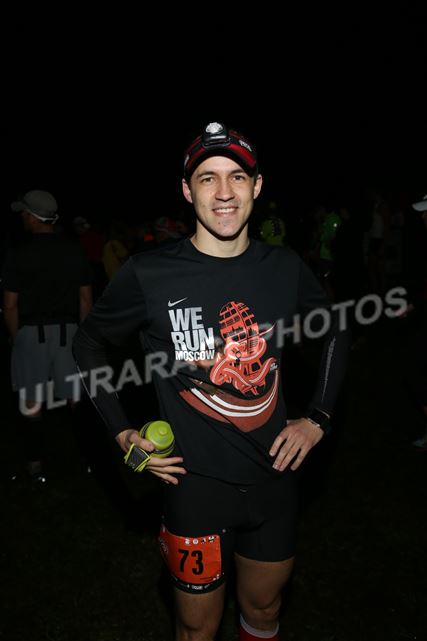
Before the start
Progress
Having watched start of the first wave I entered corral. Our wave, second, started straight away. It was 5 am, two hours until sunrise. We had to run about 1.5 mile on flat road till first hill. Far in front string of dancing lights was moving towards us. “Wow!”, - I could not refrain from exclaiming. The climb began. Instead of starting to walk I ran very slowly. The good point that heart rate was lower than when power hiking, but speed was higher. The descent was pretty steep - I couldn’t just “ride” it relaxed way. I had to reduce speed using my quadriceps as brakes. The knee gently reminded about itself. I wonder how it would fell after 20 miles?
First surprise of the day awaited me at the aid station. My plan was was to take gels from AS with me and eat one each half hour. But there were no gels - just Bloks, and it was a problem to take them into pocket. Fueling interval increases - well, OK, I grabbed 2 bloks, filled my handheld bottle with electrolyte drink and headed out to the second loop. I want to mention handheld particularly - it is very convenient to drink throughout whole run, than fill yourself with large amount of liquid. The bottle by itself was didn't cause any discomfort.
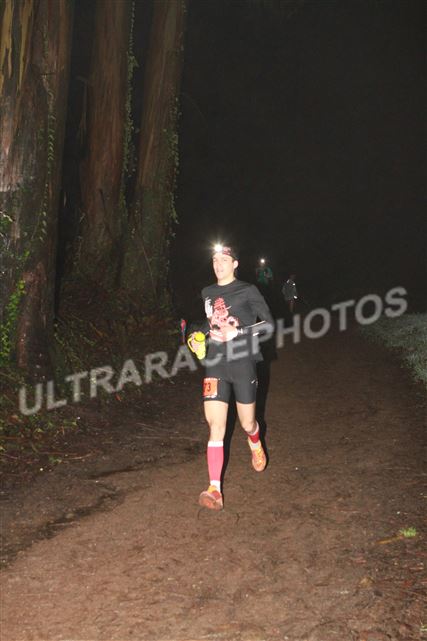
Alta Trail, 1.5 hours on the run
During the race I meet many interesting people. More than others I remembered Jason from Boulder who runs “100-milers mostly”. I was faster him, but Jason spent almost zero time at aid stations - he quickly grabbed something and ran away. I repeatedly had to chase him.
Passing station with drop bags I left headlamp and arm sleeves there.
Around half-way point there is a narrow section on a steep side of the hill with two way traffic, where only one runner could fit. Returning runners had right of the way. That creates some difficulty, but adds more dynamics - always interesting to see people in front and behind you. I was hoping to catch leaders on that section but they already had passed it.
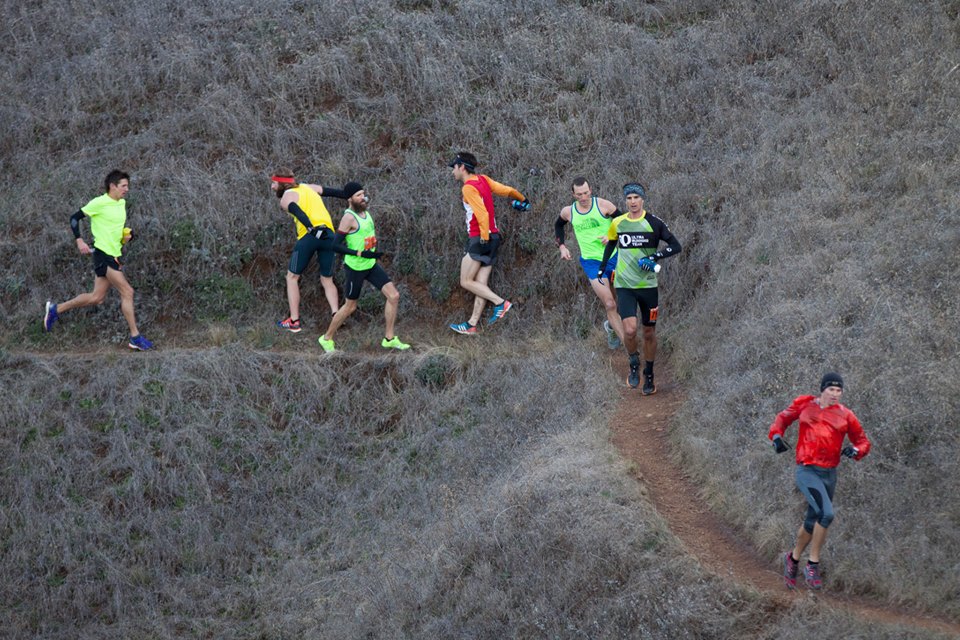
Race leader on the out-and-back section, 2013
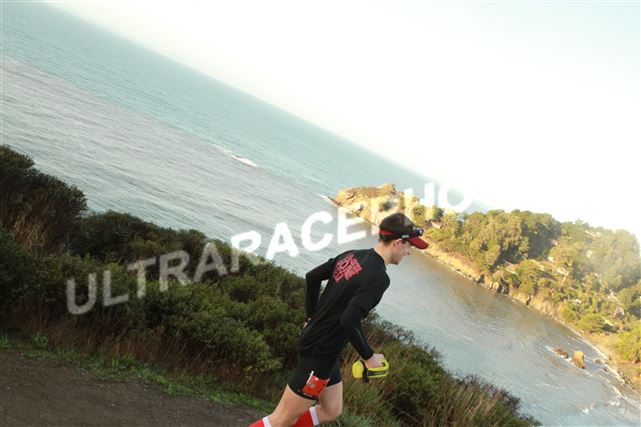
Descent to the Muir Beach aid station, ~20 miles
When this section was over, I happily responded “Yes!!” to cheering “Good job!” from the volunteers, managing traffic at the intersection and rushed down the hill. The descent went through dense wooded and was quite technical. I realized I had no problems with my legs and I felt confident on stairs and switchbacks. However my pulse was 165 bpm (at 180 bpm max) - that was a bit high. To that moment I ran 30 miles and have been on my feet for 5.5 hours. I’ve added potato chips and cola to my race diet.
At Stinson Beach aid station my pacer Ivan joined me. Pacing is a common practice at 100-milers. Idea of pacing is to keep runner safe when he or she become vulnerable, having tired and exhausted. Since that moment I could only walk uphills. If climb was steep enough, my lower back was deeply aching - I had to lean on my knees to unload my back. Probably poles would help there. I was still good on descents and was passing all who pass me during climb.
As we chatted with Ivan last 20 miles passed quickly. Climbing the last hill we talked (in russian obviously) about final section of the course. Another runner joined our discussion. His name was Stan and he lived in US there since he was 9 years old.
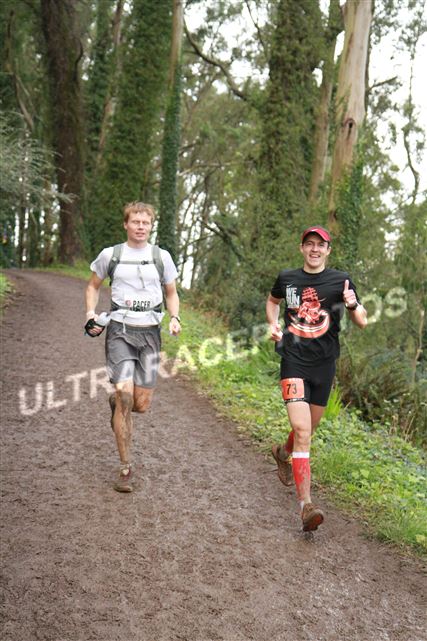
Alta Trail, last miles
And here is last aid station - it’s all the way down from there. I ate a handful of skittles with a glass of coke and I with Ivan ran to the finish. And here it is. I was feeling quite good, although being exhausted. The only thing, after long descents I beat nails on my toes and was limping on both legs. My time was 9.36, and although my goal was sub 9 hours, it would be difficult to cut extra half hour - I was running at my optimal pace almost all the time of the race. Ivan had left to his place and I decided to stay and chill at the finish festival. Soon Jason arrives. We congratulate and hug each other like old friends. We say goodbye to each other and make an agreement to run some day together again.
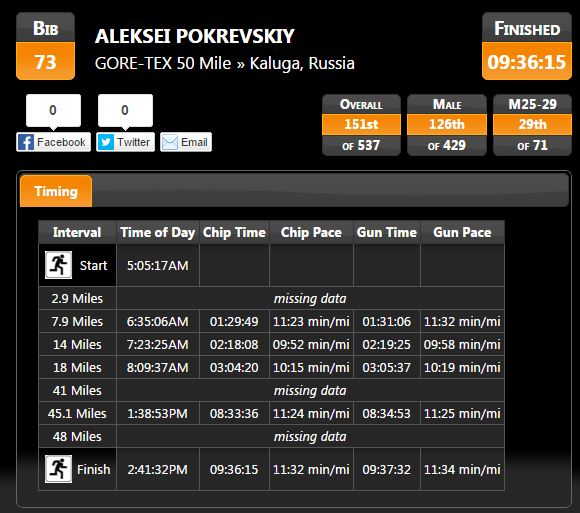
Result
I must say I had absolutely no appetite. Beer often can be seen in ultra running community, and, though, I do not consider it as a proper post-race recovery drink, but I thought it would help me to reduce tension in muscles a bit. I have mastered only couple of sips. I tried luck with real food - got plate full of pasta and chicken. I have eaten only half of a single spaghetti.
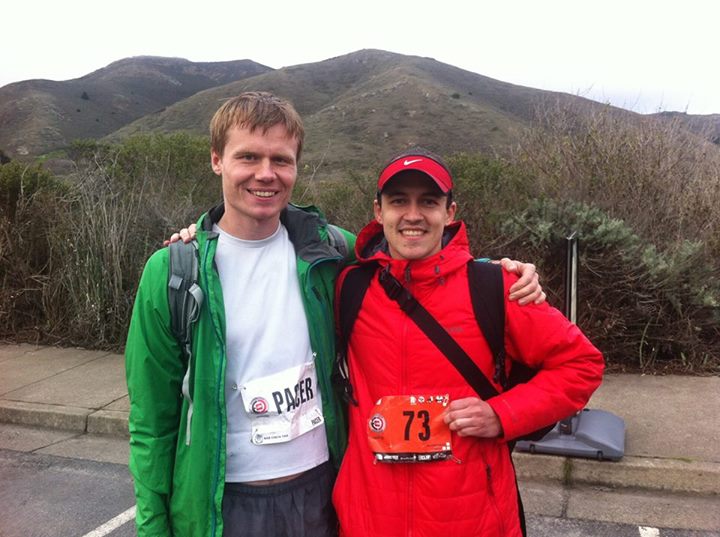
Myself, Ivan
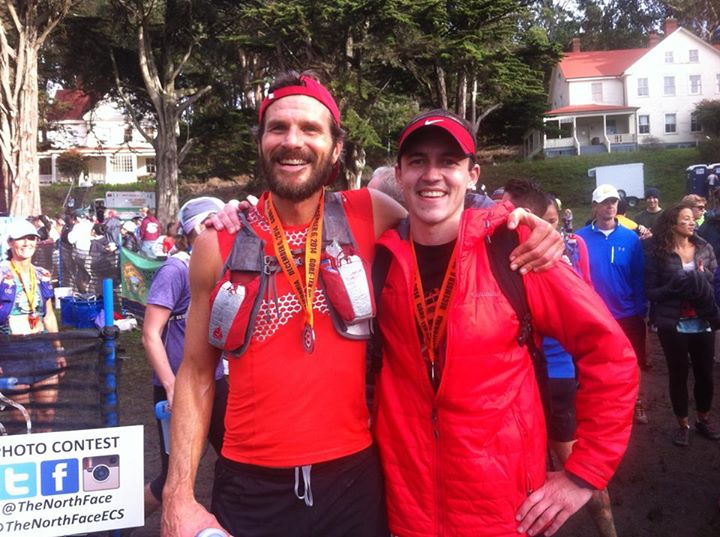
Myself, Jason
Next day I had go back to the start to pick up drop bags which I could not wait for yesterday. I was returning back in an empty bus which was going for the next portion of half-marathoners. The driver asked me about my accent. Having learnt that I’m from Russia, the driver told that he studied history of the East Europe, and now he drives a bus. “Nobody cares about history here” - his words. I found it curiously, but I don’t think it’s a common thing.
But let’s get back to the race. My conclusion - it’s a top class event, high level of organization, great course (though vulnerable to rains, which are not uncommon that time of the year). I found my performance satisfying. I didn’t met my time goal but I felt very good all the time, enjoying as much as I could beautiful nature and people around me. There is a big room for improving running uphills and downhills - it’s difficult while living in flat area, but there are always an option - it all depends on one’s purposefulness.
Gear
- shoes Brooks Cascadia 9
- Injinji socks
- Compressport calf sleeves
- Amphipod handheld bottle, 20 oz, insulated
- head torch Petzl Tikka XP2
- GPS watch Polar V800
Summary
So what is better trail or road marathon? None of them - as expected. Marathon - it is hard work for the result, while trail is for fun. I see it this way.
Links
- official web site
- official course guide
- 2012 race video (with rain)
- 2013 race course preview by Ultrasportlive.tv
- 2013 race video by Ginger runner
- video of 2014 Sage Cannaday' race
- my gps
- great resource on trail running
- North Face Endurance Challenge California - мой первый ультра. русская версия данного отчёта